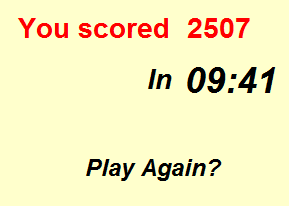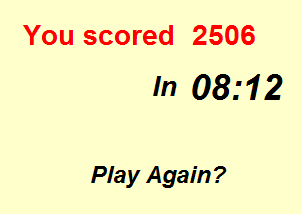Math Is Fun Forum
You are not logged in.
- Topics: Active | Unanswered
#226 Re: Introductions » Hi all » 2010-01-21 06:40:28
Promoting Cuban cigars, are you?
#227 Re: Puzzles and Games » Billiard Tables » 2010-01-21 02:30:42
#228 Re: This is Cool » A silly prime number method. » 2010-01-18 20:47:43
I take it you have not heard of the sieve of Eratosthenes.
#230 Re: Help Me ! » Chances of getting tail on a coin before 1 on a die? » 2010-01-16 14:00:57
I was assuming that the die was rolled simultaneously with the flipping of the coin.
#233 Re: Exercises » What do you think? » 2010-01-15 04:50:39
#234 Re: Exercises » What do you think? » 2010-01-15 02:44:07
An urn contains 15 balls. There are only 2 different colors the balls can have, red and orange. There are at least 3 of each color in the urn. Picking 3 balls without replacement. the probability that all of the picked ones are red is the same as the probability that exactly one of them is orange. How many of the 15 balls are red?
#235 Re: Jokes » Puns » 2010-01-13 02:21:46
.
. .
. .
.
Thats quite funny. ![]() I think theres a slight typo though. What the narrator said was deaf in two ears (which the other person misheard as dead in two years).
I think theres a slight typo though. What the narrator said was deaf in two ears (which the other person misheard as dead in two years).
#236 Re: Puzzles and Games » Billiard Tables » 2010-01-10 04:48:17
#237 Re: Puzzles and Games » Billiard Tables » 2010-01-10 00:08:09
JaneFairfax,
Absolutely amazing! Your scores and times verge on being unbelievable! Hmmm... is there a connection between number theory and being skilled at billards?

When playing any game, you have adopt a specific strategy based on that particular game. For this one, my tips for getting to 2501 or highter would be these:
(1) Go for the highest-scoring pockets.
(2) Go for the most accessible pockets and pot as quickly as possible.
(1) Obviously going for high scores such as 12 × 12 = 144 will advance your total score much more quickly than if you only try low scores like 2 × 2 = 4 (which you would have to do 36 times before your total score advances by 144). However, in some of the table configurations, the highest-scoring pockets may be rather inaccessible. In this case, (2) might be a better option. For instance, suppose the pocket marked 12 on a particular table is in a tricky corner, and it might take you 30 seconds to make a successful pot there. Then you would take one minute to make 12 × 12 = 144. On the other hand, there may be a pocket marked 9 on the same table where you can pot successfully in just 10 seconds. If you go for that pocket four times, you would score 162 in 40 seconds more points in less time than going for the awkward pocket marked 12.
Try and strike a balance between (1) and (2) to get to 2501 as quickly as possible.
#238 Re: Puzzles and Games » Billiard Tables » 2010-01-09 14:37:01
#239 Re: Jai Ganesh's Puzzles » General Quiz » 2010-01-09 09:45:53
#240 Re: Help Me ! » simple groups » 2010-01-08 14:59:15
Are you familiar with the theory of group actions? All Sylow p-subgroups of a group are conjugate, so if is the set of all Sylow p-subgroups, then acts on by conjugation and for any the number of Sylow p-subgroups is the size of the orbit of under this action. By the orbitstabilizer theorem, the size of the orbit of is the index in of the stabilizer of in , and the stabilizer of in is easily seen to be the normalizer of in .
For Humphreyss corollary, see this: http://www.mathisfunforum.com/viewtopic … 38#p109938.
#241 Re: Help Me ! » Primes » 2010-01-08 00:40:22
Because the list of numbers for does not exhaust the list of natural numbers. It just gives you finite sequences of consecutive non-primes. There will always be gaps between the finite sequences where prime numbers can fit in.
For example,
gives the sequence and gives the sequence . You can see that there is a big gap between 9 and 26 where prime numbers can be found.#242 Re: Help Me ! » abstract algebra problem(groups, rings) » 2010-01-07 11:22:43
Hint for #1:
Let
be a finite subgroup of where and . Set . Now show that .#244 Re: Exercises » What do you think? » 2010-01-01 13:16:03
Hi;
Try this one on for size, it is quite easy. Which is larger and why?
#245 Re: Guestbook » Fbi » 2010-01-01 12:58:15
Wow that is cool.
#246 Re: Exercises » Is this cool with you? » 2010-01-01 03:47:27
A person reduces the assertion that there is always a square between n and 2n inclusive for all n to this inequality:
That would be looking for a square between and . It does not imply that there is a square between and .
Correct proof of #3.
If the statement were false, there would exist a natural number
and a natural number satisfyingWith some simple algebraic manipulation, we should arrive at
It can be easily checked that there are no natural numbers
satisfying for or and so we have a contradiction.#247 Re: Exercises » Is this cool with you? » 2010-01-01 03:34:48
Hi;
How would you judge this answer? And why?



#248 Re: Puzzles and Games » Billiard Tables » 2009-12-31 15:44:17
I improved my time.

#249 Puzzles and Games » Billiard Tables » 2009-12-30 11:02:17
- JaneFairfax
- Replies: 14
http://www.mathsisfun.com/games/billiard-tables.html
The object is to score 2501 points or more. I completed the game in under 10 minutes.

#250 Re: Exercises » Fumble and Botch strike again. » 2009-12-28 04:56:35
There is nothing wrong with mods; I use them a lot too. But I also like to keep my mind open for simple solutions, if they exist. ![]()


